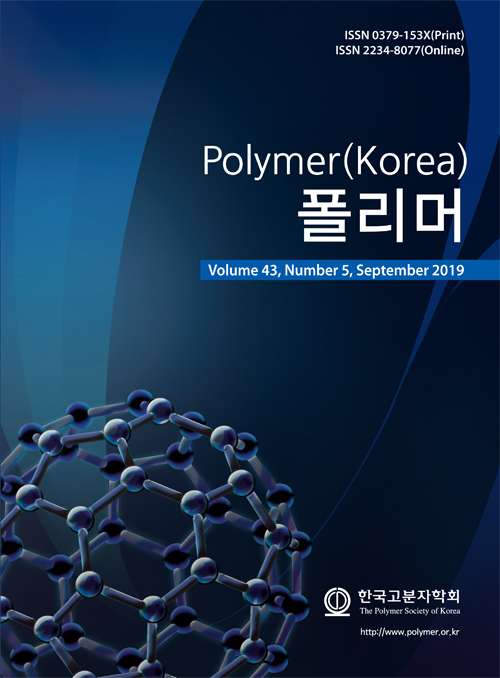- Effect of Crystallinity and Thermal Stability of Nanostructured Cellulose/Halloysite Nanotube Composites
*Department of Organic and Nano System Engineering, Konkuk University, Seoul 05029, Korea
**Division of Chemical Engineering, Konkuk University, Seoul 05029, Korea
- 셀룰로오스/Halloysite Nanotube 복합 재료의 나노 구조발현에 따른 결정화도 및 열안정성 변화에 관한 연구
*건국대학교 공과대학 유기나노시스템공학과, **건국대학교 공과대학 화학공학부
In this study, cellulose
solution was prepared using ionic liquid and its rheological behavior was
controlled by adding co-solvent (DMF) and halloysite nanotube (HNT). Cellulose
composite fiber was fabricated via electrospinning of the prepared solution. The
rheological behavior of the solution was significantly influenced by co-solvent
and HNT, resulting in the improvement of the spinnability. The electrospun
fiber showed high crystallinity and excellent thermal stability owing to the
confinement effects of HNT and cellulose chains in the fiber. The experimental
results indicate that the microstructure and the properties of cellulose fiber
can be controlled by HNT.
본 연구에서는, 이온성
액체를 이용하여 셀룰로오스 용액을 제조하고, 조용매와
halloysite nanotube(HNT)를 첨가하여 유변학적 거동을 조절하였다. 준비된
용액을 전기방사 및 스핀 코팅하여 셀룰로오스/HNT 복합 섬유 및 필름을 제조하고 미세구조와 물리적
특성을 관찰하였다. 용액의 유변학적 분석에서 조용매와 HNT의
도입에 따른 점도 하락이 관찰되었고 이는 용액의 방사성을 증가시켰다. 제조된 나노섬유와 필름을 비교했을
때, 전기방사된 섬유는 나노구속효과(nano confinement
effect)에 의해 더 높은 결정화도 및 우수한 열 안정성을 나타냈다. 본 연구결과는
나노입자 첨가를 통하여 셀룰로오스 섬유 미세구조 및 물성 조절 가능성을 보여주었다
Keywords: cellulose, halloysite nanotube, electrospinning, nanofiber, nano confinement effect
- Polymer(Korea) 폴리머
- Frequency : Bimonthly(odd)
ISSN 0379-153X(Print)
ISSN 2234-8077(Online)
Abbr. Polym. Korea - 2023 Impact Factor : 0.4
- Indexed in SCIE
 This Article
This Article
-
2019; 43(6): 958-964
Published online Nov 25, 2019
- 10.7317/pk.2019.43.6.958
- Received on Sep 2, 2019
- Revised on Sep 24, 2019
- Accepted on Sep 24, 2019
 Correspondence to
Correspondence to
- Hyungsup Kim
-
*Department of Organic and Nano System Engineering, Konkuk University, Seoul 05029, Korea
**Division of Chemical Engineering, Konkuk University, Seoul 05029, Korea
- E-mail: iconclast@konkook.ac.kr









 Copyright(c) The Polymer Society of Korea. All right reserved.
Copyright(c) The Polymer Society of Korea. All right reserved.